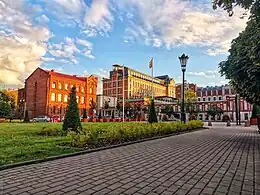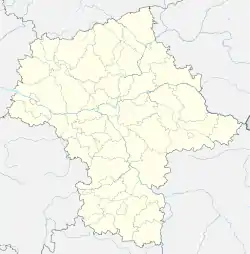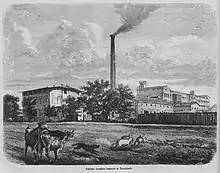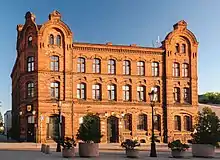Żyrardów | |
|---|---|
  
| |
 Flag  Coat of arms | |
 Żyrardów  Żyrardów | |
| Coordinates: 52°3′N 20°26′E / 52.050°N 20.433°E | |
| Country | |
| Voivodeship | |
| County | Żyrardów County |
| Gmina | Żyrardów (urban gmina) |
| Established | 1830 |
| City rights | 1916 |
| Government | |
| • City mayor | Lucjan Krzysztof Chrzanowski |
| Area | |
| • Total | 14.35 km2 (5.54 sq mi) |
| Population (2006) | |
| • Total | 41,161 |
| • Density | 2,900/km2 (7,400/sq mi) |
| Time zone | UTC+1 (CET) |
| • Summer (DST) | UTC+2 (CEST) |
| Postal code | 96-300 |
| Area code | +48 046 |
| Car plates | WZY |
| Website | www |
Żyrardów [ʐɨˈrarduf] ⓘ is a city and former industrial hub in central Poland with approximately 41,400 inhabitants (2006). It is the capital of Żyrardów County in the Masovian Voivodeship, 45 kilometres (28 miles) west of Warsaw.
Etymology
Żyrardów, initially a textile settlement, was named after French engineer and inventor Philippe de Girard, who worked in the area.
History
Origins

A textile factory founded by the Łubieński brothers opened in the village of Ruda Guzowska in 1833. One of the directors of the factory was French inventor Philippe de Girard (from Lourmarin). The village developed during the 19th century into a significant textile mill town in Poland. In honour of Girard, Ruda Guzowska was renamed Żyrardów, a toponym derived of the polonised spelling of Girard's name.
Labour movement
The terrible working conditions and inequality of the cotton mills and textile industry in Żyrardów during the late 19th century, which was in Congress Poland (part of the Russian Empire) at the time, led to a massive strike started by the female workers employed there in 1883. This event is one of the largest and most important events in the early history of the Polish workers' movement, which focused on fighting against the colonial oppressors as well as liberating the workers of partitioned Poland. The upheavals in Żyrardów were the largest protest in Poland up until the Łódź insurrection of the 1905 Revolution.[1] They remain an essential element of Polish working class history, with various forms of media dedicated to them as well as street reenactments performed annually since 2004.[2]
World War II and later
During the invasion of Poland at the start of World War II, with the onset of dawn on September 12, 1939, units of the 8th German Army launched an attack on Żyrardów. After several hours of fierce defence of the town, the Polish army had to leave their positions and start delaying actions towards Wiskitki, Guzów, Szymanów, and Paprotnia.[3] In 1941, the Germans transported local Jews into the Warsaw ghetto.
From 1975 to 1998, Żyrardów was administratively located in the Skierniewice Voivodeship.
The town museum is nowadays located in the former palace of owner of factory K. Dittrich. A sign near the entrance to the little city states that it was the only town in Europe entirely set up for a factory. The city was named one of Poland's official national Historic Monuments (Pomnik historii), as designated 17 January, 2012. Its listing is maintained by the National Heritage Board of Poland.
Monuments


Most of Żyrardów's monuments are located in the manufacturing area which dates from the 19th and early 20th centuries. It is widely believed that Żyrardów's textile settlement is the only complete 19th-century urban industrial complex to be preserved in Europe.
Education
- Szkoła Mistrzostwa Sportowego w Kolarstwie
- Wyższa Szkoła Rozwoju Lokalnego
- Liceum Ogólnokształcące im. Stefana Żeromskiego
- Zespół Szkół Publicznych nr. 7 im. Henryka Sienkiewicza w Żyrardowie
Sport
Since 1923 Żyrardów has a football club named Żyrardowianka Żyrardów (formerly Włókniarz Żyrardów), which in 2015/2016 played in the Polish IV League.
Notable people
- Feliks Łubieński (1758–1848), landowner who gave the estate and his blessing to his sons to build the very first textile factory
- Henryk Łubieński (1793–1883), banker and industrialist, son of Felix
- Feliks Sobański (1833–1913), philanthropist who donated land for the church
- Paweł Hulka-Laskowski (1881–1946), a writer, translator and social activist
- Leszek Miller (born 1946), former Prime Minister of Poland, started his professional life as electrician in a local textile factory
- Piotr Nowakowski (born 1987), volleyball player, double World Champion
- Gosia Rdest (born 1993), a racing driver who competed in the W Series
International relations
Twin towns — Sister cities
Żyrardów is twinned with:
References
- ↑ Nałęcz, Tomasz (1983). "Strajk żyrardowski (1883 r.)". Mówią Wieki (12): 6–11. ISSN 0580-0943.
- ↑ "Strajk Szpularek". muzeumlniarstwa.pl. Muzeum Lniarstwa im. Filipa de Girarda w Żyrardowie. Retrieved 2023-04-28.
- ↑ "Muzeum Mazowsza Zachodniego w Żyrardowie".
